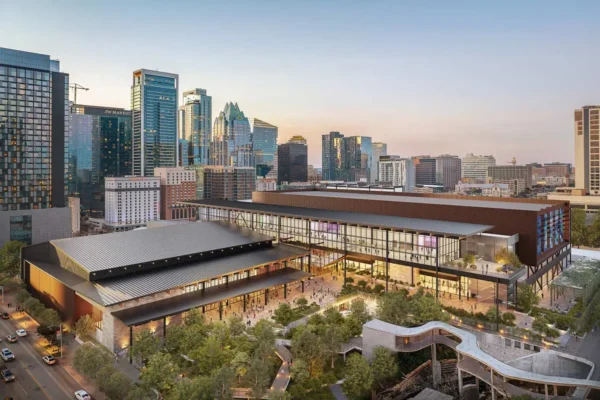Not so long ago, in the mid to late ‘70s, the first loads of aluminum extrusion systems were floated across the Atlantic. They belonged to foreign exhibitors who clearly understood the merits of shipping such systems overseas.
For example, they knew they’d have the advantage of a 20-foot by 40-foot exhibit needing only a fifth of the shipping space a custom exhibit would have demanded.
These first aluminum extrusion exhibits were critically “eyeballed” by U.S. exhibit companies, one of which immediately was eager to say that “systems would eliminate carpenter jobs” and that “the design possibilities would be rather limited.” Who, other than NASA, of course, in this country, I must ask, was even remotely interested in anything metric back then?
Then some general contractors saw the opportunity of using the extrusions to provide simple shell scheme exhibits that would look better than pipe and drape, while also offering a few more accessories. Soon these shell schemes were used until there was no straight part on any aluminum pole left, because maximum profits were sucked out of every inch of those extrusions.
This initial experimenting with systems by the general contractors helped the better custom exhibit houses attack the extrusions.
“System exhibits look cheap,” they declared, and in those early days, that line came to be used as often as those abused five-year-old aluminum posts.
With their criticism, the custom exhibit houses were shooting themselves in the foot because they didn’t see the incredible value of the systems. They instructed their designers not to engage in “the metrical metal stick design.”
Account executives of those same companies told their clients horror stories about “those ugly and cheap exhibits.” Actually, they were worried about having to learn something new, such as finding out how many millimeters fit into a meter. And they were probably more interested in their commission payments than in providing good service to their clients.
Only in the last decade did it become more obvious that even the most stubborn custom exhibit builders would have to reevaluate the use of systems to keep from losing out on a nice chunk of business.
Now everyone with a name – and even those without – uses systems such as Octanorm. They learned how much a meter is and that 10-by-10-by-10 centimeters equals 1,000 cubic centimeters, the drinkable size of one liter. Designers also learned to deal with systems, and those fortunate enough were sent to EuroShop or U.S.-based design seminars.
In the seminars, they found out there is much more flexibility in a system than they had ever envisioned. They learned that a horizontal extrusion could be applied vertically as well, and that the same was true for curved elements.
These days, more large and international tradeshows are dominated by Octanorm and “almost-like Octanorm” systems. There are the cheap knock-offs, of course, but there are also some very well-developed exhibit systems; the possibilities are endless.
Many large corporations visiting numerous shows a year – some with booth spaces of 5,000 square feet or more – even had their own systems designed and engineered. When we now stroll through any of the large U.S. convention centers, we see just about everything: from the “ugly ducklings” all the way to creations too complex and stunning to describe. What started just a few decades ago is now an incredible success story.
It’s clear that with storage space at a premium and its traditionally high transportation costs, systems such as Octanorm had to come from Europe. But now, with many U.S. exhibitors really watching their budgets and seeing how much of their tradeshow money goes into initial exhibit construction and into warehousing, shipping, drayage and use of heavy lifting equipment, it’s a logical consequence that systems cover more floor space every year.
But systems do more than simply trim costs.
In addition to the obvious initial savings, a company using systems may enter each new event with a freshly designed look, without losing corporate identity. It can exhibit on virtually any space anywhere. If, for one special occasion, its system inventory is too small, a company can just rent the needed additions for that one show. Using systems, a company can standardize its graphics and doesn’t have to re-invent the wheel every time it hits a show floor. Damaged extrusions are no problem – they can simply be cut down to the next usable size until the leftovers are ready for recycling. No landfills required here.
There are other advantages. Parts of a systems exhibit can be adjusted to find a home in a lobby or training center during the off-season while another section is used for a company event. Believe it or not, I’m using a temporary Octanorm greenhouse and deck enclosure at home for the winter.
The stuff would also be strong enough and durable enough to create temporary housing. Can you imagine all the hurricane or earthquake survivors who might benefit?
Depending on the needs of exhibitors, custom-designed elements may be easily integrated into system exhibits. And if, for any reason, some of the exhibit elements don’t make it to the show floor, the chances of a local exhibit company having the missing pieces in stock are extremely high. Just try to accomplish that with a custom exhibit – it’s not easy to build reception counters overnight or to repair the contents of a crate attacked by a runaway forklift.
Today, systems such as Octanorm’s can be found as store interiors, in modern boutiques, in duty-free shops at airports and as temporary offices. Yes, even good old Starbucks is a major Octanorm customer.
The Olympic Summer and Winter games without Octanorm? Almost unthinkable! And while I’m writing this, the contract with FIFA may already have been signed to make Octanorm a major supplier to the Soccer World Cup in Germany in 2006.
Systems will never replace true custom exhibits, but both exhibit types can, if wanted and needed, complement each other. Today, more shows in the U.S. require hard walls. Pipe and drape are nowhere to be seen.
So what’s it going to be? One exhibit on five trailers, or five exhibits on one trailer? Do the math; numbers speak!
| Home |
| People on the Move |
| National News |
| International News |
| Opinions |
| Tradeshow Calendar |






























